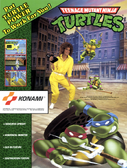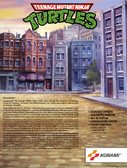(Adding categories) |
(→Trivia) |
||
| Line 67: | Line 67: | ||
* It has some references to the [[Eastman and Laird's Teenage Mutant Ninja Turtles|comic book]]. The first scene is a fire at April's apartment, this happens in the [[Teenage Mutant Ninja Turtles (film)|first movie]] and the [[Teenage Mutant Ninja Turtles (2003 TV series)|2003 cartoon]], but never in the 1987 version. At the parking lot scene, a [[TCRI|TGRI]] logo can be seen on one of the vans, in the 1987 animated show, there´s no TGRI. |
* It has some references to the [[Eastman and Laird's Teenage Mutant Ninja Turtles|comic book]]. The first scene is a fire at April's apartment, this happens in the [[Teenage Mutant Ninja Turtles (film)|first movie]] and the [[Teenage Mutant Ninja Turtles (2003 TV series)|2003 cartoon]], but never in the 1987 version. At the parking lot scene, a [[TCRI|TGRI]] logo can be seen on one of the vans, in the 1987 animated show, there´s no TGRI. |
||
* One of the achievements for the Xbox Live port is awarded for falling into an open manhole more than 5 times. You get no gamer points for this achievement. |
* One of the achievements for the Xbox Live port is awarded for falling into an open manhole more than 5 times. You get no gamer points for this achievement. |
||
| − | * The manual for the NES version describes the story as if the game is a sequel to the first movie (mentioning Shredder falling into a garbage truck where he was seemingly crushed), which is at odds with the proliferation of |
+ | * The manual for the NES version describes the story as if the game is a sequel to [http://turtlepedia.wikia.com/wiki/Teenage_Mutant_Ninja_Turtles_%281990_film%29 the first movie] (mentioning Shredder falling into a garbage truck where he was seemingly crushed), which is at odds with the proliferation of elements from [http://turtlepedia.wikia.com/wiki/Teenage_Mutant_Ninja_Turtles_%281987_TV_series%29 the cartoon series]. |
==Gallery== |
==Gallery== |
||
Revision as of 01:43, 25 January 2014
Teenage Mutant Ninja Turtles (Teenage Mutant Hero Turtles in Europe and Super Kame Ninja in Japan) was a beat-'em-up arcade game released by Konami in 1989. Based almost entirely on the pilot animated miniseries from 1987, Teenage Mutant Ninja Turtles supported from one to four players. Players could choose from Leonardo, Michaelangelo, Donatello or Raphael. The Turtles' friend April, and their sensei Splinter, have been kidnapped by the villainous Foot Clan leader Shredder, and the Turtles lead the charge to rescue them.
Each Turtle has their own slight advantages and disadvantages. Raphael has the shortest range, but is the quickest to attack. Leonardo and Michaelangelo are mid-range and have average speed, and Donatello is the slowest, but has the longest range. Pressing the Attack and Jump buttons simultaneously allows the chosen Turtle to execute a special attack which consist of a twirl with their weapons in a small jump, except for Raphael, which rolls about mid screen distance and stabs with his sai.
The game was available in two forms, one supporting 4-player simultaneous action and a 2-player version, The 4-player cabinet had each turtle fixed to a joystick while the 2-player had the option of choosing any of the turtles for both sides, however, the same turtle cannot be chosen. Home versions of the game were released for various platforms. The game featured a sample of the TV show theme song for the title screen, although it wasn't the first arcade game to feature a song. For overseas version, an alternate tune was programed in the game, in case the rights for the theme song couldn't be used; that tune wasn't used but it was featured in a Konami music CD.
Gameplay
The player chooses from one of the four Ninja Turtles: Leonardo, Michelangelo, Donatello, and Raphael. After Shredder kidnaps the Turtles' friend April O'Neil and their mentor Splinter, they must give chase, save their comrades, and defeat the evil Shredder. Up to four players (two in some versions) can take control of any of the turtles. Donatello has slower attacks but a longer range, Michelangelo and Raphael have fast attacks but a short range, and Leonardo is a well-rounded Turtle with average range and speed.
The eight-way joystick controls the movements of the Turtle, the jump button makes them jump and the attack button makes them hit in front of them using their weapon. In addition to this, some combinations are possible. The Turtles can throw Foot soldiers overhead, and by pressing the jump and attack buttons, a special attack is performed. Raphael rolls along the ground and finishes with a kick, while the other Turtles do a sweeping jump attack with their weapons. Turtles can also spring off the wall in certain areas. Enemies can be defeated more quickly by slamming them into walls or solid objects. Many objects such as traffic cones, parking meters, fire hydrants and exploding oil drums can be hit or damaged with attacks in order to help defeat nearby enemies. In the attract mode, the game showed the first part of the cartoon opening, along with a portion of the Teenage Mutant Ninja Turtles theme song.
The majority of the enemies the Turtles must face are the Foot Soldiers. They wear a different colored uniform depending on what weapon they have. The purple-clad Foot Soldiers also have the ability to hold the Turtles from behind, draining their health and leaving them open to attack by the other Foot soldiers.
Bosses
- Rocksteady
- Bebop
- Baxter Stockman (Human)
- Bebop and Rocksteady
- Granitor
- General Traag
- Krang
- Shredder
Home versions
- For the article about the second installment in the live-action trilogy, see Teenage Mutant Ninja Turtles II: The Secret of the Ooze. For the article about the 1991 Game Boy game, see Teenage Mutant Ninja Turtles II: Back from the Sewers.
Teenage Mutant Ninja Turtles II: The Arcade Game
The most well-known port of the game is on the Nintendo Entertainment System, known as Teenage Mutant Ninja Turtles II: The Arcade Game distinguishing it from the previously released Teenage Mutant Ninja Turtles video game for the NES. This is also the title in which it is known on the Atari ST. The Family Computer version in Japan retained the original title since the first game was released under a different title in Japan. The port was released in 1990, and although featured reduced graphics and only supported two players, it also added two new stages that were not present in the arcade version (the first part of Scene 3 and all of Scene 6), which culminated with the new enemy characters, including two new bosses Tora and Shogun both characters created for the game, and replaced the Bebop and Rocksteady boss fight from the second half of Scene 3, the parking garage stage, with Baxter Stockman's fly mutation. The NES version of the game was once slated for release on the Wii Virtual Console, but was quietly canceled. The NES port also appeared in Nintendo's PlayChoice-10 arcade system. This is one of the first ever home video games to feature product placement advertising in the game itself—Pizza Hut logos to be exact. The Game's manual also came with Pizza Hut coupons.
Other Ports
Teenage Mutant Ninja Turtles was also released on Commodore 64, DOS PCs, ZX Spectrum, Amstrad CPC, and Amiga. A watered-down port of the game, with edited voices and sound effects, as well as different music was an unlockable in 2004's Teenage Mutant Ninja Turtles 2: Battle Nexus for the Gamecube, PlayStation 2, Windows PC, and Xbox. In 2007, a slightly enhanced port, with some graphics from the 2007 TMNT movie in areas such as the border, and online play was released on Xbox 360's LIVE Arcade service by Ubisoft, costing 400 Microsoft Points.
Home computers
The computer ports of the arcade game released by Image Works and ported by Probe Software in 1991 for the ZX Spectrum, Amiga, Amstrad CPC, Atari ST, PC and Commodore 64. The title was changed to Teenage Mutant Hero Turtles: The Coin Op in the European versions (Hero being the re-branding of the license in Europe due to censorship issues) and lacked the extra stages and bosses from the NES game.
Xbox Live Arcade
An Xbox Live Arcade version of the game was released under the name TMNT 1989 Classic Arcade on March 14, 2007, published by Ubisoft and ported by Digital Eclipse. Like other classic arcade games on the Xbox 360 platform, portions of the original arcade game are emulated with network code and other new features added. Players can earn achievements as well as play 2-4 player co-op (both online and offline). Certain aspects, such as the character select screen, were based on images from the 2007 film. It has since been removed from XBLA.
Teenage Mutant Ninja Turtles 2: Battle Nexus
The arcade version of Ninja Turtles is included as a hidden bonus game in Teenage Mutant Ninja Turtles 2: Battle Nexus for the PlayStation 2, Xbox, and GameCube. The version featured in the game is a port of the original arcade version, but with altered music and most of the voice clips edited out.
Trivia
- Part of the soundtrack was released in Japan in the CD set, Konami Special Music Senryo-Bako Heisei 3 Nen-Ban (KICA-9005~8), released in December 21, 1990, they skipped the tunes that are completely based on the show soundtrack.
- It has some references to the comic book. The first scene is a fire at April's apartment, this happens in the first movie and the 2003 cartoon, but never in the 1987 version. At the parking lot scene, a TGRI logo can be seen on one of the vans, in the 1987 animated show, there´s no TGRI.
- One of the achievements for the Xbox Live port is awarded for falling into an open manhole more than 5 times. You get no gamer points for this achievement.
- The manual for the NES version describes the story as if the game is a sequel to the first movie (mentioning Shredder falling into a garbage truck where he was seemingly crushed), which is at odds with the proliferation of elements from the cartoon series.









